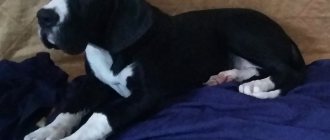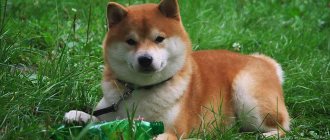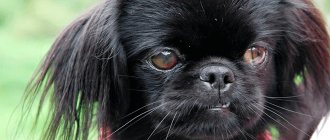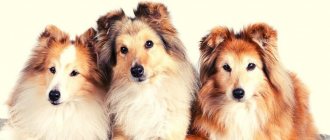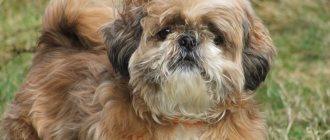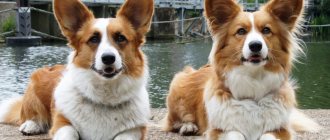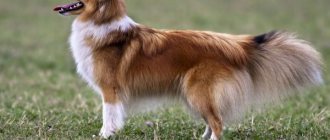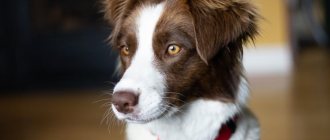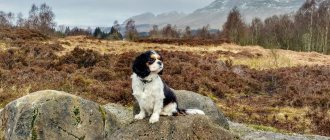Description of the Newfoundland breed
Popularity 32nd among 263 dog breeds
Lifespan:
9-11 years
Height:
males: about 71 cm, females: about 66 cm
Country of origin:
Canada
Average price:
20-40 thousand rubles
Weight:
males: about 68 kg, females: about 54 kg
Latest articles Cat health
Rabies vaccination for cats: choice of vaccine, necessity, schedule 01/22/2022 4 0 0
Selection and adaptation
TOP 20 best cat breeds for families with children 01/22/2022 25 0 0
Breed traits
Breed traits (on a 5-point scale)
| Newfoundland | |||
| Activity | in the house | 1.5 | |
| on the street | 2.3 | ||
| Obedience | training | 3.6 | |
| strangers | 3.8 | ||
| Domination | in family | 1.5 | |
| over dogs | 1.8 | ||
| Defending your territory | from people | 1.1 | |
| from dogs | 1.4 | ||
| Sociability | in family | 4.2 | |
| with strangers | 3.8 | ||
| with dogs | 3.3 | ||
| Concentration | in family | 2.2 | |
| in front of strangers | 2.3 | ||
| with dogs | 2.5 | ||
| Aggressiveness | in family | 1.2 | |
| to strangers | 1.4 | ||
| to the dogs | 1.5 | ||
| to cats | 1.8 | ||
| Family behavior | calmness | 3.9 | |
| demand for affection | 3.5 | ||
| excitability | 2.2 | ||
| playfulness | 3.1 | ||
| excessive barking | 1.5 | ||
| behavioral breakdowns | 1.8 | ||
| Tolerance for children | up to 4 years | 4.5 | |
| over 4 years old | 4.6 | ||
| Institutional use | watchman | 2.2 | |
| bodyguard | 1.5 | ||
This breed is often compared to the following dog breeds: St. Bernard, Labrador Retriever, Caucasian Shepherd, Leonberger, Golden Retriever.
The photographs show what Newfoundlands look like:
Newfoundland dog
Newfoundland breed
Newfoundland dog face
Dog diver
Diver
Key facts
The Newfoundland is a large, strong dog with an attractive exterior and a good-natured character. Serving people is the meaning of life for her.
It is unlikely that you will be able to look at representatives of this breed without a smile of tenderness. A bear dog can scare anyone with its size. But once you look into the four-legged eyes, you will immediately feel his kind heart and generous disposition.
The description of the Newfoundland breed mentions the origin of the name. It is related to the island of Newfoundland, located in the eastern part of North America and belonging to Canada. Other abbreviated names for the dog are diver, newf.
Newfoundlands are loved not only in their country of origin, but throughout the world. Such fame became possible thanks to the docile nature, incredible loyalty to the owner, courage and extraordinary appearance of the animal. Reviews from owners speak of them as an inexhaustible source of love, happiness and devotion.
There are often references to their use as companions during long expeditions. They also took part in combat operations, helping orderlies drag the wounded. The characteristics of the Newfoundland breed say that due to their enormous size, the dogs can act as rescuers.
Females are slightly smaller than males in all respects. Their weight reaches 54 kg, while males weigh about 68 kg. The height at the withers of females reaches 66 cm, the height of male Newfoundlands is up to 71 cm. The life expectancy of Newfoundlands is short, only 9-11 years.
Character
The Newfoundland is a balanced dog, prone to obedience and trust. She will never bark for no reason, attack anyone, rush around the territory aimlessly, or behave inappropriately. Any good-natured person who loves four-legged pets can cope with this animal.
This is a very gentle and loving animal that needs affectionate treatment. Yes, the huge fluffy dog inside is a real lap dog. He is sensitive, neat and always friendly. It was this set of positive qualities that served as the reason for his rapid gains in popularity. People like to spend time with a huge beast that is absolutely not dangerous.
Some people mistakenly think that divers are a guard breed. No, that's not true at all. As a watchman and bodyguard, he is ineffective. Aggression, long concentration of attention and suspicion are a standard set of guard inclinations that are not typical for our furry giant.
But, in everyday life it performs a number of other useful functions. Nature has endowed the Newfoundland with a love for all living things, especially for two-legged owners, that is, people. In any situation, he feels like their protector.
The main purpose of the dog has always been and remains to save drowning people. Is it worth talking about the advisability of taking it with you to a body of water? He loves water, especially swimming in it with his loved ones. He enjoys playing together, swimming and diving. If a diver sees or smells a drowning person, he will instantly take off and rush to his defense. He will ask absolutely nothing in return. This breed is a real miracle.
Loyalty is to all members of the household, and not to just one of them. From early childhood, they outline the boundaries of their pack in their minds and identify themselves as part of it. They divide all living beings into friends and foes.
This is normal for such a dog. Doesn't bark for no reason and is virtually silent most of the day. They become strongly attached not only to people, but also to pets, which they are forced to part with. He can even be friends with cats.
Newfoundland is characterized by independence. He sometimes likes to be the center of attention, but he also doesn't mind spending time alone. Can independently come up with an interesting activity and have fun while being alone.
This large dog is perfect for living with a large family. He gets along well with people of different ages: children and even old people. He will surely become everyone's favorite. They will allow the kids to do absolutely any pranks with them.
Don't be afraid that the diver will bite your child or otherwise harm him. This is absolutely impossible. Such huge dogs are quite forgiving and tolerant. When playing with a person, a diver dog will not stop monitoring his safety and will not lose vigilance. The rescuer instinct will never “turn off” in such an animal.
History of the origin of Newfoundlands
There are many stories about the appearance of this breed. Unfortunately, most of them are far from the truth.
Many cynologists call the ancestors of Newfoundlands the European bear-catching dogs that lived in the Middle Ages. These Berenbeiters arrived on the island on the Scandinavian ship of the Viking Leif Eriksson around the year 1000. Over time, the descendants of the dogs went wild and turned into huge black dogs with long shaggy hair. This is how the first Europeans saw them when they arrived here in the 16th century.
Professor from Switzerland Albert Heim talks about the origin of the breed from Molossians - mastiff-like dogs similar to mastiffs. They were brought to the territory of modern Canada from England during colonization.
Large black and piebald shepherds are also cited among the possible ancestors of the breed. They also mention white Pyrenean mountain dogs, brought by settlers from Spain and Portugal.
Most Canadian scientists believe that Newfies descended from local sled dogs used by Eskimo tribes. This version is supported by the pet’s increased friendliness and its determination to always come to the aid of a person.
The first written mentions of dogs appeared at the very beginning of the 18th century. There is a known name associated with a large settlement on the island: the dog of St. John. Even then they mentioned their excellent working qualities, good nature, and ability to swim or dive well.
The British began to export these animals, and then started breeding them. Two types of dogs were created: retrievers and Newfoundlands. The name was last given by George Cartwright in 1775.
At the beginning of the breeding process, black and white individuals were used for mating, then preference was given to quadrupeds only black in color.
The breed became popular in the second half of the 19th century. It was then that the fashion for large dogs appeared in Great Britain. At the exhibitions of those years in Birmingham, Newfies were a great success. Giants became pets of noble people. So, in 1864, the Prince of Wales’s pet won first place at a competition in England.
Since 1878, Newfoundlands have been included in the Kennel Club stud book in Great Britain. Then clubs of lovers of these bear-like individuals began to appear. In 1885, such a place was opened in the USA. In Russia, the first divers began to be found at the beginning of the last century among the pets of aristocrats. After 1945 they were brought from Germany.
Soviet dog handlers took part in improving the working qualities of Newfoundlands. They were bred with shepherd dogs to make them more aggressive. But such experiments were not successful.
Interesting Facts
One of the most important facts about the breed: Newfoundlands are good-natured people, aggression is unknown to them.
The second point is the love of water; representatives of the breed love to swim.
In third place is the independence of these dogs. They are used as rescuers, which requires making quick and correct decisions. Not every person has this ability, but Newfoundlands have it.
On the fourth line is a tendency to various diseases. The Newfoundland dog, mistakenly called the diver, is quite sickly.
Speaking about divers, it is worth noting that the breed was bred in the Soviet Union (Krasnaya Zvezda nursery). Obtained as a result of crossing a Newfoundland with a Caucasian Shepherd, Rottweiler, Giant Schnauzer, and Great Dane. Currently, this breed does not exist; it differed from the Newfoundland both in appearance and in character.
The Newfoundland's lifespan is extremely short, with many members of the breed only surviving to 8-9 years of age. Occasionally you can find a dog whose lifespan is 11 years.
Newfoundland appearance
General impression
Divers are very similar in color and size to bears. This powerful individual has an athletic build and a luxurious fur coat. Despite its large size, the dog has good control of its body. The latest exterior standards appeared in 1996, at which time they were enshrined in the description and photo of the Newfoundland. All dogs that did not match them were discarded.
Head
Large, with a wide skull and slightly protruding vault. The bump on the back of the head is clearly visible. The Newfie's muzzle is short, almost square in shape, and completely covered with short, silky hair. There are no folds, the cheeks are soft to the touch. The color of the nose corresponds to the color of the pet and can be black or brown.
The Newfoundland's jaws are very powerful, with large white teeth. The bite resembles a scissors. Small, wide-set eyes are dark brown with a light tint. Small ears are located closer to the back of the head, they look like triangles with round tips.
Neck
The Newfie's thick neck is covered with strong muscles, but it is also very mobile. There is no pronounced dewlap on this part of the body, and it is quite long. It is the neck that helps maintain the majestic posture of the animal's head.
Torso
The body of the Newfoundland is large, strong, but compact. The length of the body from the beginning of the withers to the tail is equal to the length of the withers to the floor. The dense and wide back and croup look very solid. The chest, together with the lower back, has strong muscles. The bottom line is completely flat. In females, the body is more elongated and less massive compared to males.
Forelegs
According to the standards, the front legs should be parallel and straight. The shoulders are well developed and directed back. The pasterns are slightly inclined.
Hind limbs
The hind legs are characterized by well-developed hips and long, strong shins. The pasterns on the hind legs are set low, but do not protrude in or out. Rounded feet correspond to the size of the body. The claws are black in black animals and pink in brown ones.
Tail
The diver's tail is wide in itself and flared at the base. It acts as a rudder if your four-legged friend is swimming. In a standing position, the Newf's tail is slightly lowered with a noticeable bend. You can't have him on his back or tucked between his legs.
Movements
The giant moves with powerful sweeping movements. The back remains straight. During tireless running and acceleration, the pet places its limbs close to the middle.
Wool
The hard, waterproof coat appears smooth with a perfectly acceptable wavy pattern. The undercoat with a hard structure becomes even thicker in winter. Most noticeable in the chest and croup areas. Feathers are visible on the Newfoundland's paws.
Color
The colors of Newfoundlands are not very diverse. Black is the most common pet color. In summer, slight fading is possible. Brown color can be chocolate or bronze shades.
Black and white individuals are also present among divers. In this case, white becomes the main one, and black can be the head, the base of the tail, and part of the croup.
Size
The height of females is about 66 cm, males - 71 cm. The weight of female Newfoundlands is 54 kg, males - 68 kg. The size of Newfoundlands requires that they be kept in a spacious house or kennel.
Breed standard
Today, divers regularly take part in all animal events, including international exhibitions. They are treated there with honor and respect. The Newfoundland in the photo looks terrifying. Although, as you know, first impressions are deceiving. This is a large dog with strong bones and strong muscles. It weighs from 55 to 72 kg. Of course, males are much heavier than females. The height of the animal is from 65 to 70 cm.
The breed is valued, first of all, for its harmonious complexion. All parts of her representative’s body must fit well together. So, against the background of a wide, large back, a voluminous head looks harmonious.
The diver's skull is slightly convex. The nose is very wide and dark. The dog's entire face is covered with short, shiny hair. The peculiarity is that the skin is tightly adjacent to it. The cheeks are wide and drooping.
The dog's eyes are set deep, often covered by the upper fold of skin. This is necessary to protect against water and sand. The color of the iris is brown. In light-haired animals it may be dark beige. But their ears are small and thin. They have the shape of a triangle and are set wide. The ends of the ears are curled.
The diver's neck position is good. She is muscular and long. The front legs are also muscular and strong. Set wide apart. But the rear ones are stronger. The elbow joint is well defined on them. The dog needs it in order to push off well from the ground for jumping, as well as for fast swimming. There are so-called dewclaws on the diver's hind legs. They are of no use, so it is recommended to remove them.
The base of the tail is wide. This part of the Newfoundland's body is one of the most important for its rescue function. The tail of such a beast is its rudder. Even it has muscles, albeit small ones. When the animal is in a calm state, its tail is lowered, but as soon as it gets excited, it immediately rises up and begins to spin in different directions.
Interesting ! A dog's mood can be determined by the movement of its tail. If he spins to the right, the dog is in a positive mood, he is cheerful and wants to play, but if he spins to the left, the situation is the opposite.
According to the standard, a diver should not have a wide chest. This shape of this part of the body would prevent it from freely maneuvering in the water.
The animal's coat is two-layered. He may be a little nervous, but not frizzy. The dog's undercoat is very delicate, soft, and dense. The fur on the muzzle, forehead and tips of the paws is short, while on the rest of the body it is long.
3 types of colors of such dogs are allowed:
- Pure brown. The shade can be any - milk chocolate, dark chestnut, baked milk, etc.
- Pure black. The color is rich, monochromatic. It must be uniform.
- Black and white. The body of the animal is dominated by fur of two shades - light and dark. The ideal version of this color is the head is black, the neck is white, and the back has both colors.
Newfoundland character
Representatives of this breed have an easygoing character. They are very tactful, loyal, friendly and kind dogs. Their presence in the house will create an atmosphere of warmth, calm and safety.
Socialization of four-legged giants occurs from their very birth. All they need is to be useful to a person, to serve him. They are capable of heroic deeds and can provide assistance in almost any situation.
Newfoundlands have proven themselves excellent in working with the military or police, as guards or guide dogs. Even diver puppies are not capricious; they do not make noise or bark for no reason. As adults, dogs are very smart and resourceful. They can form opinions about something and even ignore meaningless commands.
At the same time, the Newf understands when his help is needed. To save a person, he does not need orders. Here he himself can calculate everything, make a decision and react. This indicates the high intelligence of the animal.
Despite its large size, it is easy for a diver to adapt to life in a city apartment or in a country house. He will not disturb you with his presence if he understands that his company is currently undesirable. The pet enjoys going on country walks in the car, without creating noise or fuss.
Giant dogs love children very much and are ready to play with them all day long. At the same time, parents can be calm about their children, because not only will they not be offended, but they will also monitor their safety.
The Newfoundland will also find contact with other pets. Even if they don’t become close friends, they will definitely respect each other.
The pet becomes attached to its owner for life. He distinguishes a person’s mood well by a person’s intonation, and is ready to do anything for him. When a family changes, the pet will accept new owners, but its heart will be broken.
Due to their good-natured nature, Newfoundlands cannot be called good watchdogs. They do not have lightning-fast aggression towards a stranger. But, having analyzed the situation and sensing danger, they will attack with all their enormous power.
Features and description
The Newfoundland dog is a great friend and companion. She has a natural intuition that allows her to accurately guess the mood of every person with whom she interacts. But the main feature of the breed is not good nature at all, but a well-developed rescue instinct.
This is one of the few dogs that can not only swim well, but also dive expertly. He does this in order to save a drowning man. A dog diving into the water smells a person in need of help. It is unique in that it has a so-called superior sense, which allows it to accurately determine the smell of a drowning living creature not only on land, but also in the aquatic environment.
Yes, the dog searches for a person drowning in water, relying not on sight, but on smell, that is, smell. When a person is found, the dog pulls him up, firmly grasping his neck with his teeth. At the same time, it does not cause injury. His grip is firm but not painful. When the drowning person is pulled to the surface, the animal will swim with him to the shore. His second name is diver.
Evidence that Newfoundlands love water dates back to the 18th century. In old sources, experts found information that these animals swim, dive well and have amazing endurance. It is impossible to say exactly how long such a dog must swim before getting tired.
Previously, fishermen often took the dog with them to help retrieve nets with their catch that were immersed deep in the reservoir. The animal's ability to dive was highly valued by them. When the dog took the net out of the water, he did not claim the fish. He has an inherent desire to help people selflessly.
The fame of representatives of this breed quickly spread throughout the world. They were wanted by rich and poor people, aristocrats and representatives of the proletariat class, adults and children, in general, all dog lovers.
The birthplace of the Newfoundland breed is one of the Canadian provinces. In the 19th century, dogs began to be actively exported to England, where local breeders were engaged in their further selection. The preferred color requirements have changed many times. In 1986, a diving club was first organized in England. But the breed gained its greatest popularity only in the 2000s.
Education and training
Conducting training with Canadian breed animals is a pleasure. They have a sharp mind, they grasp everything on the fly. From puppyhood, the dog understands everything immediately and even without fully listening to a requirement or command, strives to fulfill it.
We must remember to use a calm tone when giving orders and patience. We must not forget to encourage the pet, who, having felt the approval of the owner, will take up work with redoubled force, will readily and willingly respond to a request or order.
Before you start training a dog, a young Newfoundland is taught:
- to the rules of hygiene;
- respond to your nickname;
- walk on a leash.
Training exercises can be carried out at any time of the year. Due to the characteristics of their coat, they are quite comfortable in any weather. You need to alternate between group training and individual training. It’s great if the Newfoundland is raised and trained under the guidance of a trainer or an experienced dog breeder. A well-bred giant will delight its owner throughout its life.
Appearance
The Newfoundland is a large dog with a powerful, athletic build. With its luxurious thick fur and head shape, it resembles a bear. Due to his colorful appearance, his images are often found on stamps and coins.
The height of dogs at the withers is on average 66-71 cm, in some individuals it reaches 80 cm. Weight is 54-68 kg, sometimes more. Despite such large size, the dog does not look heavy or clumsy. She is harmoniously built, her movements are well coordinated. The appearance features are determined by the 1996 standard, which is not very different from the first one adopted in the 19th century.
Photos of Newfoundlands:
Head
The skull is large, wide, convex, with a pronounced occipital protuberance. The stop is not sharp, but clearly noticeable. The muzzle is quite short, almost square in shape. The cheeks are soft, the corners of the mouth are clearly defined. The lips are fleshy, hang down, but do not reveal teeth. There are no folds on the muzzle.
The nose is large, wide, black or brown, depending on the color of the dog. The jaws are powerful, the teeth are large. The bite can be either straight or scissor.
The eyes are small, dark brown in color; in brown individuals they may be lighter. The eyelids should not droop. The eyes are set quite deep and slightly slanted. Because of this, the look seems sad. The ears are medium-sized, triangular, with rounded tips. Set closer to the back of the head, hanging down.
Torso
The physique is massive, muscular, strong bones. The body shape is square. In bitches it may be more elongated in length. The neck is muscular, without dewlap. The back is wide, straight, the croup is sloping. The chest is deep, voluminous, but not wide, the stomach is not tucked.
The tail is wide at the base, tapering towards the tip. It is strong and acts as a rudder in the water. When at rest, it is lowered, reaches the hock joints, and bends slightly. Never rolls over on its back.
Limbs
The forelimbs are straight and muscular. Remain parallel even when the dog moves. The shoulders are directed back, the elbows are close, the pasterns are slightly inclined. The hind legs are powerful, with wide, muscular thighs. The shins are strong, the knee joints are pronounced. Hocks parallel, short.
The paws are wide and rounded. The fingers are gathered into a ball, with membranes between them. The movements are light, sweeping, free. The dog is able to run a long distance and swims very well.
Coat and colors
Double wool, water-repellent. The dog's entire body is covered with long, thick, fairly stiff guard hairs. They are usually straight and smooth, but can be slightly wavy. The undercoat is double, very thick and soft. It is especially dense on the chest and rump. Thanks to these features of their coat, these dogs are not afraid of severe frosts and cold water, but do not tolerate heat well.
The hair on the tail is long, without undercoat, and the paws have feathers. On the head it is shorter, thinner and softer. There is no collar on the chest and neck that would prevent the dog from swimming. The soft, silky undercoat, which can be combed out, is recommended to be spun. This wool is good for knitting socks, mittens, sweaters, and anti-radiculitis belts. Things turn out warm and waterproof.
The most common color found in Newfoundlands is black. The color is rich, anthracite, uniform. Sometimes it fades in the sun, acquiring a brownish tint. The standard allows two more varieties of color. Brown color from milk chocolate to dark bronze. The color is uniform, sometimes small white spots on the chest, toes, and tail.
White Newfoundlands with spots are rare. This black and white color is called Landseer. The dog's head and ears are black, with a white stripe on the forehead, large black spots at the base of the tail, and a saddle on the back. Silver-gray Newfoundlands are even rarer. In America they are classified as a separate breed. But in Russia this color is not recognized and gray individuals are not allowed to exhibit.
The pictures complement the description of the Newfoundland breed:
Newfoundland Health and Diseases
Possible diseases
Newfies can be called strong not only for their appearance, but also for their state of health. Indeed, pets rarely get sick, although they live only 9-11 years. The main reason for their diseases is body weight, which creates problems with the musculoskeletal system.
Due to the large build, your pet may develop hip dysplasia. This is a hereditary incurable disease that manifests itself at different ages and leads to lameness.
Panosteitis, or inflammation of the long bones, is also a common disease in large breed dogs.
Many health problems can be caused by poor diet or overfeeding of a diver. We are talking about problems with intestinal function, flatulence, food allergies, and obesity. Excess weight can cause heart problems.
Bred in cold climates, dogs do not tolerate heat very well and may suffer from heat stroke. Its signs include lack of appetite, lethargy, and a dry and warm nose.
Routine and preventive vaccinations against a number of diseases help maintain good health: rabies, hepatitis, enterovirus, parainfluenza, distemper, salmonella, leptospirosis. Complex vaccination is carried out at 1.5 months, then repeated at 2 months, six months and a year. After 12 months, vaccinations against a complex of diseases are given annually.
Reproductive health
Puberty in females occurs at 10 months. From this age, it is possible to perform an operation to sterilize a dog, but it is not yet ready to give birth to healthy offspring.
Mating is carried out during the third heat, which occurs at 20 months of the bitch’s life. Mating is carried out on the territory of the male dog, and it should be quite large for the future parents to be comfortable.
How to buy a Newfoundland puppy
It is better to buy a Newfoundland from a special nursery. Then there will be a guarantee that the puppy is purebred, without defects and hereditary diseases. The price of such a dog in Moscow is 30-40 thousand rubles. In the regions the cost is less - 20-30 thousand. Offspring from champion dogs will be more expensive - from 50 thousand rubles. You can buy such a dog from someone else or on the market for 5-10 thousand rubles.
Newfoundland puppies for sale at 1.5-2 months. At this age they weigh 7-12 kg. When choosing, you need to pay attention to the breed characteristics and behavior of the animal. The puppy should not be cowardly or aggressive. A healthy baby is cheerful, curious, and playful. He has shiny fur, eyes and ears without discharge. It is advisable to check all the documents, study the mother’s behavior, and the conditions in which the animals are kept.
The photo shows what the puppies look like:
More interesting photos characterizing dogs of this breed:
To decide whether to get a Newfoundland, you need to watch another video:
Video: Newfoundland - All about the breed. Interesting facts about Newfoundland
Video: Newfoundland. Breed characteristics
Video: Newfoundled. Breed characteristics, care
The Newfoundland is a kind dog, suitable even for inexperienced owners. She doesn’t require a lot of walks, she is easy to train, very smart and loyal. But she needs emotional contact with her owner; she gets very bored alone. Therefore, it is an ideal friend and companion for large families, for people working from home, and retirees. This breed is not suitable for those who are rarely at home and cannot pay attention to their pet.
Features of feeding and diet
Feeding the powerful Newfoundland should be balanced and moderate due to its tendency to overeat and become obese.
When choosing dry food, owners do not have problems enriching the dog’s diet with additional vitamin and mineral complexes. This type of food should be purchased premium or holistic.
Natural food must contain at least 50% protein. These can be lean varieties of beef, lamb, rabbit, meat by-products or sea fish fillets. The meat is given in boiled, minced form in combination with porridge or vegetables. The best cereals for Newfoundlands are rolled oats and buckwheat, but it is not recommended to include rice, pearl barley or millet in the menu.
From the age of one month, puppies begin to be fed with low-fat fermented milk products, cottage cheese, boiled eggs, and oatmeal. It is useful to add grated carrots, cabbage and greens to your food. We must not forget about clean water.
Sometimes it is useful for a diver to have fasting days. On such days, which are held no more than once every two weeks, dogs are given rye bread crackers, boiled or raw vegetables.
Prohibited products include:
- sweets and chocolate;
- flour products;
- pork, poultry;
- salted, smoked or spicy;
- potatoes and berries with seeds.
The Newfie's menu should be varied, but feeding from the master's table or allowing food to be picked up from the ground is prohibited. This can lead to food allergies and gastrointestinal problems. Therefore, you cannot respond to a pleading look with a request for more or a tasty piece from the owner’s plate.
Puppies up to 6 months are fed about 5-6 times a day. As the dog grows and matures, the number of feedings is reduced to 2 times. It is considered correct if the dog leaves the bowl clean after feeding. Otherwise, the nutritional intake is reduced.
Breed characteristics and character
The dog's country of origin is Canada, and the second name of the Newfoundland breed is diver. The animal not only loves this element, but has a specific paw structure - membranes between the toes. Thanks to them, the four-legged pet swims excellently.
However, the ancestors of the modern breed were not hunters. In this regard, the Newfoundland lacks the corresponding instincts, and cats and birds are considered play partners. This dog is not an aggressor at all. He rarely feels anger and almost always trusts strangers.
However, the above does not mean that the dog is not capable of guarding the home or protecting the owner. These animals are very sensitive and are able to sense a threat from a distance, but at the same time they have their own opinion, which does not always coincide with the opinion of the owner.
Training can be a very difficult task. But the dog sees service to its owner as the meaning of life. He is incredibly loyal and ready to help constantly if circumstances require it. The dog will be courteous with guests and affectionate with children.
If we are talking about a puppy, then he will happily play with the kids. An older dog will consider himself a nanny, who is not suited to fuss and cheerful chaos. Teenagers will be able to win favor if they interact with the Newf politely.
Black Newfoundland on a walk
And in general, this animal belongs to those breeds that perceive requests rather than orders much more clearly. The whip method does not suit them at all. The dog is offended by rudeness and leaves, demonstrating offended feelings.
Care and maintenance
Newfoundland dogs feel equally comfortable in open space and in city conditions. Divers do not shy away from cars or pursue them. They are not familiar with such deviations in behavior.
But keeping giants in small apartments is not worth it. They are better suited for living space in medium-sized high-rise buildings or a country house with its own plot. Ideally, there will be a body of water near the house in which the pet can swim to its heart’s content. It is not worth keeping a diver in an enclosure, much less putting him on a chain, because he will be sad due to the lack of communication with the owner and members of his family.
Newfies must be given a separate place where they can rest or sleep comfortably. This could be a small mattress or bed with an orthopedic base. The dog doesn't run around the house or chew furniture, so you don't have to worry about repairs.
Pets need active walking on a leash in the city or without it in parks and open areas. The walk is carried out at least twice a day, if possible in the morning and evening.
Newfoundlands require regular and quite complex care. Long-haired dogs are brushed with a stiff brush at least three times a week. If this is not done or not done too often, the Newfie’s fur will roll into tangles, which will cause itching and dermatitis of the skin. It is best to carefully unravel the discovered tangle.
Twice a year, the pet’s thick undercoat is renewed. This molting occurs in autumn and spring. During this time, the fur is combed every day. You can contact a groomer who will give you a haircut that will make it easier to care for the giant’s hair.
The pet's hard fur, impregnated with a special lubricant, does not require frequent washing. Dirt and moisture do not penetrate the skin, but the use of various shampoos worsens the condition of the coat. So bath days can be arranged only a few times a year.
Once a month, it is recommended to trim your Newfoundland's nails using clippers and a nail file to handle uneven areas. To prevent inflammatory processes, his ears and eyes are periodically wiped from accumulated dust and dirt. To do this, use chamomile decoction, special drops and lotions, or chilled boiled water.
Keeping and caring for a Newfoundland will be a joy if you teach the dog to hygiene procedures from childhood.
Nutrition
If you think that large dogs eat a lot and often, you are mistaken. Their diet must be balanced and measured. Adult divers eat 2 times a day. The optimal daily food intake for them is 1 kg.
Newfoundland puppies grow healthy and strong only if minerals and vitamins predominate in their menu. Preservatives, flavorings and food additives should be excluded from it. So, here is a list of recommended products for them:
- Vegetable soup (with a minimum amount of salt).
- Lean meat, not subjected to heat treatment.
- Milk and cottage cheese.
- Buckwheat or wheat groats (you need to add a little butter).
- Bananas, peaches, apples and other fruits.
- Raspberries, blackberries, watermelon and other non-acidic berries.
- Beets, carrots, cucumbers and other vegetables.
- Boiled potatoes.
- Offal.
Do not give your baby diver hot food! They will burn his larynx. Every month the puppy will gain weight. By the age of 10 months, it is recommended to switch him to canned food - food.
An alternative option is dry food. We advise you to buy high-quality products so that your pet always remains healthy. Refrain from adding spices and herbs to your dog's dishes. They retain water in his body, causing severe thirst and constipation.
Tips for choosing a puppy
Only when purchasing a Newfoundland puppy from a nursery can you be sure that the standards of exterior and pedigree of the future pet will be met.
When making a choice, ask to see the baby’s parents, observe his behavior and feeding. You can purchase a pet 45 days after birth. But a four-month-old puppy should already have a veterinary passport with information about vaccinations against a range of diseases and rabies.
A small pet should look like a miniature copy of an adult. He should be energetic, inquisitive, strong. A healthy puppy's coat is shiny, looks clean and free of tangles. But you need to understand that the price of a pet with a pedigree will be quite high.
Newfoundland puppies look cute, so you should choose based on the behavior of the future family member.
How to choose a puppy
Newfoundland puppies with mother
Newfoundland puppies, of course, need to be purchased from a kennel or from a breeder in whose integrity you are confident. In this case, you will have guarantees that the baby is purebred and has all the necessary vaccinations. At the nursery you will be able to meet his mother, and, if you’re lucky, even his father. This will give you the opportunity to get an idea of what your grown “bear cub” will look like.
According to the rules of the RKF, breeders have the right to sell puppies after they are 45 days old. But many people prefer to buy babies who have already received all vaccinations, that is, at the age of 3-3.5 months. In this case, they can already be walked without fear. Those who want to buy a puppy for breeding should wait until he is 6-9 months old, when the peculiarities of his anatomy and behavior will be obvious.
A small Newfoundland should have a proportionate build and be a tiny replica of an adult dog. A puppy is supposed to be active, curious, and moderately well-fed. His fur should be shiny and clean, without tangles, and his bite should be correct.
Newfoundland dog breed price
These dogs are common in all countries of the world, but they are not included in the list of cheap breeds. The cost of a puppy varies from 300 to 1000 dollars, depending on the pedigree and documents. The average price is $500.
Important! You should not buy puppies that cost less than $250, as they are most often a mix of breeds. Mixed puppies are often aggressive and disobedient.
Divers make good companions, friends and family members. Those who started such a miracle will not regret it. Newfies are capable of love, giving all of themselves.

